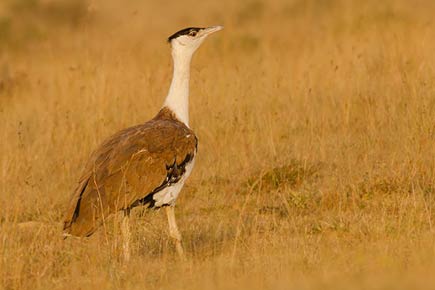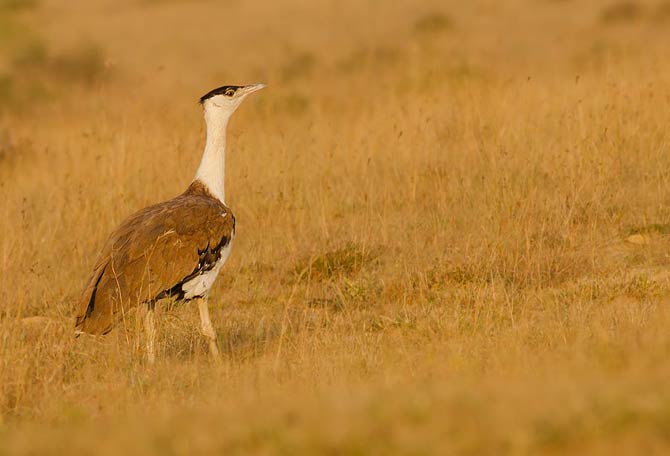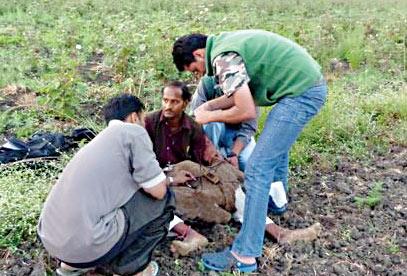A landmark telemetry study reveals that the endangered species frequents farms in central India

In A journey that began last year, two Great Indian Bustards (GIBs) have voyaged a distance of 1,600 km in nine months in a first-of-its-kind telemetric study. Their flight, with radio-collars around their necks, has contributed to several important findings in this study by the Maharashtra Forest Department and the Wildlife Institute of India (WII). Called Tracking the GIBs in Maharashtra, it is expected to help with the conservation of this endangered species.

The Great Indian Bustard, the heaviest of flying birds
ADVERTISEMENT
On February 10, 2015, two male GIBs arrived at the Bustard Sanctuary in Nannaj, Solapur district. Sightings of these birds are next to impossible, and the sanctuary, which expects GIBs during the breeding season from April to October, at that time, had a total population of four. A team of scientists headed by Dr Bilal Habib undertook pre-capture monitoring activities. Dr Habib, a wildlife scientist from WII, recounted, “In April 2015, the dominant male Alpha mated with a female GIB — an incident that had occurred for the first time in six years. After the departure of the female from the sanctuary, we decided to capture the male bird, since we had extensive data on its behaviour to predict its movement. The other male bird, a sub-adult one, was captured on April 17, 2015, using noose traps, and both were fitted with a 70 gram Solar Argos GPS.”
According to the tracking report, GPS information from the birds was tracked from April to December 2015, at seven time slots each day and Argos (another transmitting device) locations on alternate days. Till January 10 this year, 1,390 GPS locations and 670 altered Argos locations were plotted.

Dr Bilal Habib (in green t-shirt) and his team put a radio collar on a Great Indian Bustard for their study which started in April 2015
Since tracking commenced, several clusters of locations have been identified across Maharashtra. During the first 55 days (between April and May), the GIBs used not just the grasslands of the Nannaj Bustard Sanctuary but also the adjoining agricultural lands belonging to villages of Mardi, Narotewadi, Raleras and Banegaon. Chief Conservator of Forest, Pune Wildlife, Sunil Limaye, said that after leaving the protected grasslands of Nannaj in the second week of June, all other locations for the GIBs were found in human-dominated agricultural lands. The farthest movement away from the sanctuary was to Tolnoor in Karnataka (62.1 km aerial distance).
Satellite telemetry had aided not only in discovering new sites used by bustards, but was also successful in identifying new individuals in the population. According to the data obtained, on July 1, 2015, a tagged bird arrived in an area near Akkalkot town bound by the villages Ugadi, Galoragi and Basalegaon where he was present until the end of August. This human dominated agricultural landscape is 54 km away from Nannaj. At this site, two new birds were identified in the company of the tagged male. After interacting with locals, it was found that GIBs were seen here during the breeding season for the last two years.
Important findings from the study
>> The tagged birds spent four months within the protected grasslands of Nannaj Sanctuary and seven months outside the protected area.
>> Areas frequently used by tagged bird were spared lands, left by farmers for grazing their livestock. The crops grown in GIB-frequented areas are primarily rain fed and the farming practices were less intensive, indicating it to be bustard-friendly.
>> Ground-tracking revealed that GIBs used these areas for resting, foraging and as a cover to avoid predation.
>> GIB sightings and satellite telemetry data have indicated that these birds use large areas outside Protected Areas. It is therefore imperative to protect and conserve habitats within and outside the sanctuary. Small pockets of breeding sites need to be developed. Hence, a multi-pronged strategy is required.
>> Methods to protect GIBs in human dominated ecosystems can adopt strategies like land sharing or land sparing. Organic farming is advised to reduce pesticide and insecticide usage around these areas.
Why track the gib?
As a committed effort towards the conservation of these birds, protected areas (PAs) were established to safeguard the GIB habitat. In Maharashtra, the state government established the GIB Sanctuary in 1979 in Solapur and Ahmednagar districts. After an initial rise in population of GIB, the numbers declined post 1990. Simultaneously, bustard populations have been reported outside the Sanctuary ever since 1982. Unavailability of data on bird movement and migration poses a colossal challenge for managers.
 Subscribe today by clicking the link and stay updated with the latest news!" Click here!
Subscribe today by clicking the link and stay updated with the latest news!" Click here!







